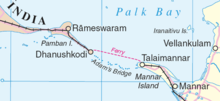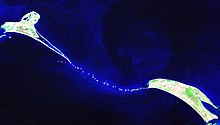Setu Canal
The Setu Canal , also known as the Sethusamudram Shipping Canal Project , is an Indian project to build a waterway through the reef arch between India and Sri Lanka , known as the Adam's Bridge .
geography
Between India and Sri Lanka lies the flat Palk Strait and an arch of islands and reefs , which in India begins with a pointed peninsula and continues over the island of Pamban , which in turn points in a long spur to the chain of islands and coral reefs known as the Adam's Bridge . The Adam's Bridge ends in Sri Lanka at Mannar Island , which is only separated from the main island of Sri Lanka by a narrow, shallow channel. The Adams Bridge can only be crossed by small fishing boats. Small coastal ships without high superstructures can drive through the Palk Strait and the Pamaban Passage between the island of Pamban and the Indian mainland, for which the Pamban railway bridge must be opened. Larger ocean-going vessels have to take the route south around Sri Lanka. For shipping from one Indian coast to another, a passage through the Palk Strait would mean a considerable shortening. For ships from the Suez Canal or the Persian / Arabian Gulf , the shortening would be less significant. Traffic from East Asia would not be affected.
The project
The idea to build the Setu Canal came from the British Commander Alfred Dundas Taylor, who proposed the construction of a waterway between India and Ceylon in 1860 to shorten the sea route between the Bay of Bengal and the Arabian Sea by 424 nautical miles. Numerous variants were investigated over the next 140 years, such as: B. a canal through the peninsula or through the Pamban Passage or through the island of Pamban. In 1999 the plan that had been raised again and again by the Indian military was brought out again and expanded into a feasible project over the next seven years. It was approved by the government and inaugurated on July 2, 2005 by Prime Minister Manmohan Singh.
The construction
The Sethusamudram Shipping Canal Project provides for a 167-kilometer-long and 300-meter-wide shipping lane with two 14.5-meter-deep fairways along the Indian peninsula to connect the Indian west and east coasts with a navigable fairway. The future canal will allow ships 290 meters long, 33 meters wide, 12.8 meters draft and a load capacity of around 65,000 tons to pass through. The fairway leads from the western Gulf of Mannar through the shallow water area called Setu Samudram between India and Sri Lanka to the northern Palk Bay . The coral reefs of the Adam's Bridge (Indian, Ram Sethu) are cut through and the fairway in the Palk Bay is deepened.
In detail, around 82.5 million cubic meters of sediment have to be moved over a distance of 83 kilometers in two construction phases. Around 35.5 million cubic meters have to be dredged on the 54-kilometer northern stretch between Kodiyakkarai and Manalmelkudi in Palk Bay, and 48 million cubic meters of dredged material has to be removed in the southern section between Tuticorin and Kodiyakkarai . The northern construction section in Palkbucht is silted up every year by the monsoon rainy season and will therefore require constant maintenance dredging. The project was estimated to cost around $ 550 million.
Criticism and resistance
The construction of the canal is criticized by various groups, and in some cases actively opposed. The main points of criticism are the ecological risks, the economic and political effects as well as the violation of the religious feelings of part of the population involved.
The National Environment Engineering Research Institute in Nagpur approved the construction of the shipping lane, which is associated with numerous ecological dangers. These result from the unexplained consequences of the large-scale change in the hydromorphology of the sea area. For example, the canal changes the flow conditions of the previous shallow water zone. An indirect consequence could be the unpredictable effect on the wave formation of future tsunamis . During the tsunami of December 26, 2004, the sea area acted as a brake on the ocean circulation of backflowing water around Sri Lanka. The handling of the large quantities of dredged spoil is also unclear. The spreading of the dredged material in the Palkbucht could, for example, cause problems due to the cloudiness of the water alone. One suggestion to solve this problem is to create artificial islands on the Indian coast.
Sri Lanka sees its economic interests at risk through the canal. In addition, in 1976, during the negotiations to draw the border between India and Sri Lanka, it was agreed not to build a canal. It is also conceivable that future shipping traffic could be endangered by Sri Lankan rebels.
Domestically, the construction of the canal is used as an instrument by various Indian parties and groups. This topic overlaps with the religiously based demand not to cut the Adam's Bridge. The project has been brought before the Supreme Court of India , which issued a preliminary decision prohibiting damage to the Adams Bridge (without prohibiting any other dredging), but the final decision is pending (as of January 2010). Meanwhile, the estimated costs have risen significantly and the funding commitments have expired.
literature
- Christophe Jaffrelot: Hindu Nationalism and the (Not So Easy) Art of Being Outraged: The Ram Setu Controversy . In: South Asia Multidisciplinary Academic Journal . tape 2 , no. 2008 ( revues.org ).
- Onno Groß: A new way to Madras . In: Deutsche Seeschifffahrt 12/2008 . Hüthig Jühle Rehm, Hamburg 2008, p. 24-25 .
Web links
- Website of the Sethusamudram Corporation Limited (English)
- Contribution of the University of Kassel on political resistance
- Contribution to modernrationalist (English)
- Website of the environmental hazards (English)
- Website of the religious danger (english)
- Information page of the Indian military (English)
- Article on the conflict (English)
Coordinates: 9 ° 5 ′ 38 ″ N , 79 ° 32 ′ 48 ″ E



